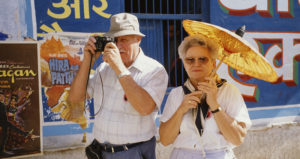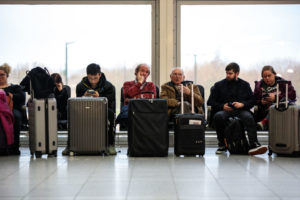Look up images of Alpe di Siuse and Lago di Braies on Instagram, and you will find thousands of posts showing what appears to be a glorious alpine meadow and a captivatingly secluded glacial lake, ringed by the peaks of the Dolomites. It’s almost always the same view — the mountain money shot. Sometimes in the foreground of the image, there is a solitary hiker or, in winter, a lonely skier; on the lake, there may be a single, un-manned boat. They are images that would warm the cockles of any searcher for the Romantic experience of the sublime for the last 200 years, of humanity thrillingly put into perspective by the grandeur of nature.
The reality behind the view, however, is somewhat different. The peaks are there, all right; the meadow is indeed beautiful, the lake is crystalline. But a visitor to Alpe di Siuse or Lago di Braies will have to contend with some of the largest crowds of tourists in Europe; a staggering 34 million people a year. If you yearn for a solitary communing with nature, you will find many, many others have had the same idea.
Now the local population of the region of Trentino Alto Adige, which amounts to only a million people, have had enough. This summer, the local tourist board has instigated a cap on visitor numbers, and between July and September, anyone wanting to come in by car will need an online permit. Entry to the meadow will be restricted to the hours between 9am and 5pm, and to the lake between 9am and 4pm. It will put paid to getting your own Insta-breaking shot of the sunset over the mountains. Bureaucracy has stepped in to keep the romantic touristic ideal alive.
“Over-tourism” is killing — in some cases, has long since killed — what tourists think they seek: the sightseeing industry has become a snake compelled to eat its own tail. Venice, now simply a palimpsest of a real, living city, charges an entrance fee to day-trippers, because they add to the stifling crush of people but less to the economy that overnighters.
Sooner or later, any place advertised as “unspoilt” must buckle under the weight of visitors looking for unspoiltness. On the once-mysterious island of Santorini, the coast road is crammed, nose to tail, with coaches full of cruise passengers who’ve disembarked for a couple of hours. The clifftop over the caldera is blocked three-deep with tourists taking selfies at sunset. Wedding parties queue to get photographs with the view behind them. It feels less like a place than a backdrop.
In France, which attracts 90 million tourists a year (the highest number of any country in Europe), regional tourist boards have now resorted to begging visitors to stay away from the obvious and over-stuffed destinations, such as Mont-Saint-Michel, and spread the load of numbers to lesser-known routes. Pressures of infrastructure, of water, health services and traffic make once-lovely places often disappointing for the holidaymaker (so very unlike the promise of those Insta images) and both impossible and expensive for the people who must actually make a home there.
Barcelona — at 15,800 inhabitants per square kilometre, already one of the most crowded cities in Europe — attracts 32 million visitors every year. (In 1990, there were 1.8 million.) Half this number are day-trippers who spend their money only in the main tourist areas and souvenir stalls, while the proliferation of Airbnb apartments drives up local rents and forces locals out of the centre.
Few people seek out crowds when travelling. The tourist experience is almost always characterised by those selling it in terms of exclusivity, serendipity and particularity. The beach is “tucked away”, the restaurant is “local”, and in the guidebook the cathedral appears to be empty but for a discerning few. The reality, however, is that the beach is generally crammed, as is the restaurant, which is also vastly expensive — and for the cathedral, you must queue round the block for entry.
Modern tourism has long been a battlefield between the competing desires of individual and collective experience. In 1861, a Times leader denounced what it viewed as the modern craze for “rushing about in crowds”, which it found was represented by the tours of Thomas Cook. Cook’s answer was that tourism had for too long been the preserve of a “flirting, listless” aristocratic elite; he was opening up the world for the education of the middle classes, for the “thoughtful tourist”. Where people of leisure merely “wandered” about, Cook’s clients were working people wishing to use their short periods of time off in a guided, directed manner. They wanted to be pointed to what was “good” and what was “beautiful” and to learn about it. They wanted to have experiences.
But with everyone looking for a view or an experience, before long, the view and the experience were inevitably made less attractive by other people. Those who thought they had a majestic landscape to themselves were outraged. In 1867, Minnie Thackeray, daughter of the novelist, deplored the sight of the “trippers and excursionists” flocking to Mont Blanc (which now gets 6 million visitors a year). Ruskin, whose dislike of “fast travel” was intense, thought that the inhabitants of the mountain village of Chamonix were degraded by turning their woodworking skills to making ornamental alpenstocks to sell to tourists.
A century later, in the Sixties — the period that saw cheap air travel bring unprecedented numbers to the Mediterranean and transform small fishing villages into vast resorts — anthropologists first used the phrase the “tourist gaze”. This gaze had had a profound effect on communities whose craft traditions and religious ceremonies were now simply part of a package of attractions served up to seasonal visitors. Had these traditions become mere husks, empty of meaning? Were they now understood in terms not of their own deep roots within landscape and history, but only in relation to an audience fleetingly interested in a bit of local colour?
The first tourists were medieval pilgrims for whom the outer journey had an inner, spiritual purpose. But modern tourists who encounter religious festivals abroad often don’t share or understand the deeper significance of what they are witnessing. Smartphone images constitute the 21st-century equivalent of an 18th-century cabinet of curiosities. It is a pic-n-mix assortment of cultural bits and pieces to be stored and (perhaps) looked at long after the moment in which the original was experienced.
Ruskin was a snob about travel. He saw no reason why he shouldn’t himself travel slowly in his own coach about Europe (he deplored trains, which he saw as inculcating the peculiarly modern vice of endless distraction), as long as he didn’t have to suffer the presence of crowds of his less-cultured countrymen. But his warning of tourism’s endless and inevitable roll-out of blandness and standardisation seems prophetic and pertinent today. For Ruskin, always to be moving somewhere else, always planning a destination far away, was to risk missing the details of where we actually are. In the search for difference or novelty (that view over the mountains; that bluer sea; that Instagrammable seafood feast), we bypass the deeper pleasure of looking more intimately at what is close and familiar.
In his 2002 book The Art of Travel, Alain de Botton points out that to sketch a tree would take at least “10 minutes of acute concentration”, a length of time that would rarely be given to any examination of a tree in the age of the smartphone. Like Ruskin an advocate of slow travel, de Botton also glosses over the fact that attending to the details of your own locality is a lot easier if you live somewhere even just a bit lovely — and it may be that the more we rely on going somewhere else for loveliness, we risk neglecting to respect the places that we live in.
But as the high spots of popular destinations become more crowded with people and more emptied of atmosphere, perhaps it’s time to re-think what it means to be a tourist — to try and pin down what it is the tourist really hungers for. The tourism industry is a product of 19th-century Romanticism, perhaps its most visible living legacy. It is ever on the lookout for new ways either to re-package the sites of the past or to sell the sensation of a wonder that has often long since been jaded by exposure.
Among its commodities are “heritage” and “experience” — both of which have to be carefully curated to maintain the appearance most likely to evoke feelings of the sublime. But the localism, the crafts, customs, and food, which is also central to the tourists’ sensation package is meaningless if there are no real locals to embody it. Keeping tourists out may give communities space to recover themselves. In the spirit of Ruskin in making travel a little more challenging, a little slower, it may encourage a resurgence in the art of really looking. More importantly, it should encourage an examination of what tourism means for places so buckling under the strain of numbers that, for their inhabitants, they are no longer places for living, working and being, but simply for propping up an unsustainable artifice.
Disclaimer
Some of the posts we share are controversial and we do not necessarily agree with them in the whole extend. Sometimes we agree with the content or part of it but we do not agree with the narration or language. Nevertheless we find them somehow interesting, valuable and/or informative or we share them, because we strongly believe in freedom of speech, free press and journalism. We strongly encourage you to have a critical approach to all the content, do your own research and analysis to build your own opinion.
We would be glad to have your feedback.
Source: UnHerd Read the original article here: https://unherd.com/



